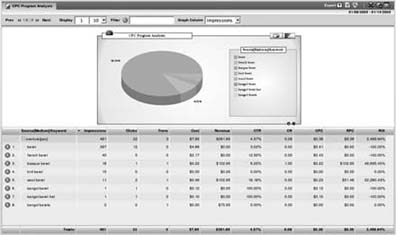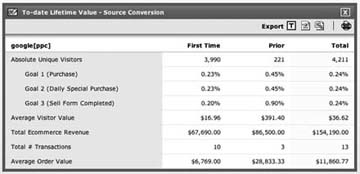Hack37.Understand Marketing Terminology
Hack 37. Understand Marketing Terminology
Online marketers have their own language and lingo, always asking about your "CPA" and the "CPC" for a campaign. Online marketing is a pretty well-established activity, but one full of sometimes vague and often confusing terminology. While you're already able to talk the talk [Hack #1] using web measurement lingo, here are a handful of marketing specific terms that you need to know. 3.2.1. Reach and AcquisitionThe first terms we'll examine are the "big picture" measures and metrics for visitor reach and acquisitionthe measurements that help you understand how well or poorly a campaign is doing in helping you find and attract prospects to your web site. 3.2.1.1 Click-though rate (CTR).Your campaign click-through rate is the ratio of impressions you serve to the number of clicks those impressions generate (clicks divided by impressions measured in page views). Click-through rate tells you whether the particular message you're using is well written, well presented, and well targeted to the particular audience you're trying to reach (Figure 3-1). Figure 3-1. Paid keyword marketing dashboard Your campaign click-through rates can be difficult to calculate because impressions are often served by external servers and usually require that data is imported into your measurement solution. Also, some advertising servers don't actually measure or report on clicks, forcing you to use responses as a proxy for clicks. 3.2.1.2 Cost-per-click (CPC).Campaign cost-per-click is a direct measure of how well your marketing dollars are spent. Literally, the total cost of the specific campaign divided by the number of clicks it generates, cost-per-click is the standard model for search engine marketing (often called the pay-per-click model). 3.2.1.3 Response rate.Your campaign response rate is the number of respondents (unique visitors) divided by the total number of impressions you serve or unique emails you send. This is similar to your click-through rate but based on real people, not actions. Don't be surprised if you have a much higher click-through rate than response rate [Hack #51]. 3.2.1.4 Cost-per-acquisition (CPA).Campaign cost-per-acquisition is the total cost of the campaign divided by the number of respondents (unique visitors). Similar to cost-per-click, cost-per-acquisitions are a direct measure of how well your money is being spent. As you can hopefully see, you're working for higher response rates and lower costs-per-click and acquisition. Maximizing inbound traffic while minimizing costs becomes important when you start to examine how well you're doing in actually converting the people you manage to acquire. 3.2.2. ConversionAll of your efforts in reaching and acquiring visitors are for naught unless you're able to somehow entice your respondents to complete some valuable action. Regardless of the type of site you have, there is always an act of conversion [Hack #39] you should be measuring. 3.2.2.1 Conversion rate.One of the most fundamental and valuable web site measurements, conversion rate is loosely defined as the number of completions divided by the number of potential completers. A number of hacks in this book discuss specific conversion rates, but in the context of online marketing, your campaign conversion rate is usually the number of conversions measured in visits divided by the number of visits the campaign drives to the web site. 3.2.2.2 Cost-per-conversion (CPC).Your campaign cost-per-conversion is simply defined as the total cost of the campaign divided by the number of conversions it drives. Another important measurement is the value-per-conversion or, if you're really good with numbers, margin-per-conversion. The value measurement is total sales divided by number of conversions; the margin measurement is total sales minus costs divided by conversions. 3.2.2.3 Revenue per visit or visitor.Very simply, revenue per visit or visitor is the amount of revenue a campaign drives divided by the number of visits or visitors from the campaign. Calculating revenue per visit or visitors allows you to look at the overall effect of your marketing efforts and provide a good comparator for specific marketing strategies like banner advertising [Hack #40] and search keyword marketing [Hack #42]. 3.2.2.4 Order and buyer conversion rates.While a number of different conversion rates are described throughout this book, two are important and poorly understood enough to be defined explicitly here. If you sell anything online, your order conversion rate is the number of orders taken divided by the number of visits; your buyer conversion rate is the number of customers divided by the number of unique visitors. For example, say your site generates the following data in a week:
By comparing our order and buyer conversion rates, we immediately realize that we're getting additional purchases from visitors who are coming back to the site (twice a month as a global average). To compare, say you generated the following data over a week:
In this case, you can easily determine that visitors are visiting and purchasing only once during the week, which is fine except return customers are often much more valuable than one-time customers. As you can hopefully see, very reasonable numbers can generate fairly different conversion rates. The difference is subtle, but important and worth understanding. If someone tells you his conversion rate is 3% you should ask him if he means "order" or "buyer" conversion rate. 3.2.2.5 Return on investment (ROI).To make the micro-ROI calculation, you need only three numbers: the amount you spend on a marketing campaign, the amount of revenue (or value) the campaign drives, and the timeframe you're interested in. According to Jim Novo, web marketing guru, simple return on investment is calculated in the following way:
For example, let's say that you spend $1,000 on a banner advertising campaign and that the visitors these banners attract end up generating $600 in value in the first week. Your ROI for the first week would be:
This demonstrates the importance of the third variable in the equation: time. You want to be cautious when making these calculations to consider the ebb and flow of different types of campaigns. Assuming, in the example above, the banner ads were scheduled to be delivered over the course of a month, and at the end of the month, you had generated $2,200 in revenue. Now your calculation would be:
Some people choose to calculate a rolling return on investment, breaking the costs up over time. Continuing our example, and again examining the first week of the four-week campaign (e.g., $250 per week), the rolling ROI calculation becomes:
The rolling ROI calculation is often helpful when you're examining your success for ongoing campaigns like pay-per-click search marketing where you'll have variable daily expenses based on the cost-per-click and number of clicks. We recommend that you calculate both a rolling and simple return on investment for the campaigns you run. The rolling calculation will help you understand whether you're likely to be successful; the simple calculation will show you whether you were successful after the fact. 3.2.3. RetentionRetention metrics are among the most complicated concepts, since they depend on a variety of factorsany one of which can prevent making an accurate measurement if something goes wrong. Retention is most often measured by using a cookie [Hack #15], a small file stored on a visitor's computer that is easily deleted, preventing your measurement application from recognizing that a visitor has been "retained." Still, measuring retention and lifetime value driven by your campaigns is important to your online marketing efforts. 3.2.3.1 Visitor retention rate.Your visitor retention rate is the number of return or repeat visitors divided by the total number of visitors the campaign helped you acquire. Depending on your particular site, service, or offer, you may want to examine this rate over long periods of time (e.g., depending on what you sell, your visitors may not return for months after the initial campaign response). 3.2.3.2 Lifetime value of a campaign.The lifetime value of a campaign is a very complicated metric that describes the long-term value of a visitor, usually by original acquisition source (Figure 3-2). Covered in detail in the hack on lifetime value of a customer [Hack #84], lifetime value is usually defined as the total value of visitor actions (purchases, downloads, etc.) by original acquisition device (campaign, referring site, and search keyword or phrase). Figure 3-2. Lifetime value report While there are many other important metrics you'll read about in this book, the metrics in this hack form the framework for measuring the effect of your online campaigns. Bryan Eisenberg and Eric T. Peterson |
EAN: 2147483647
Pages: 157